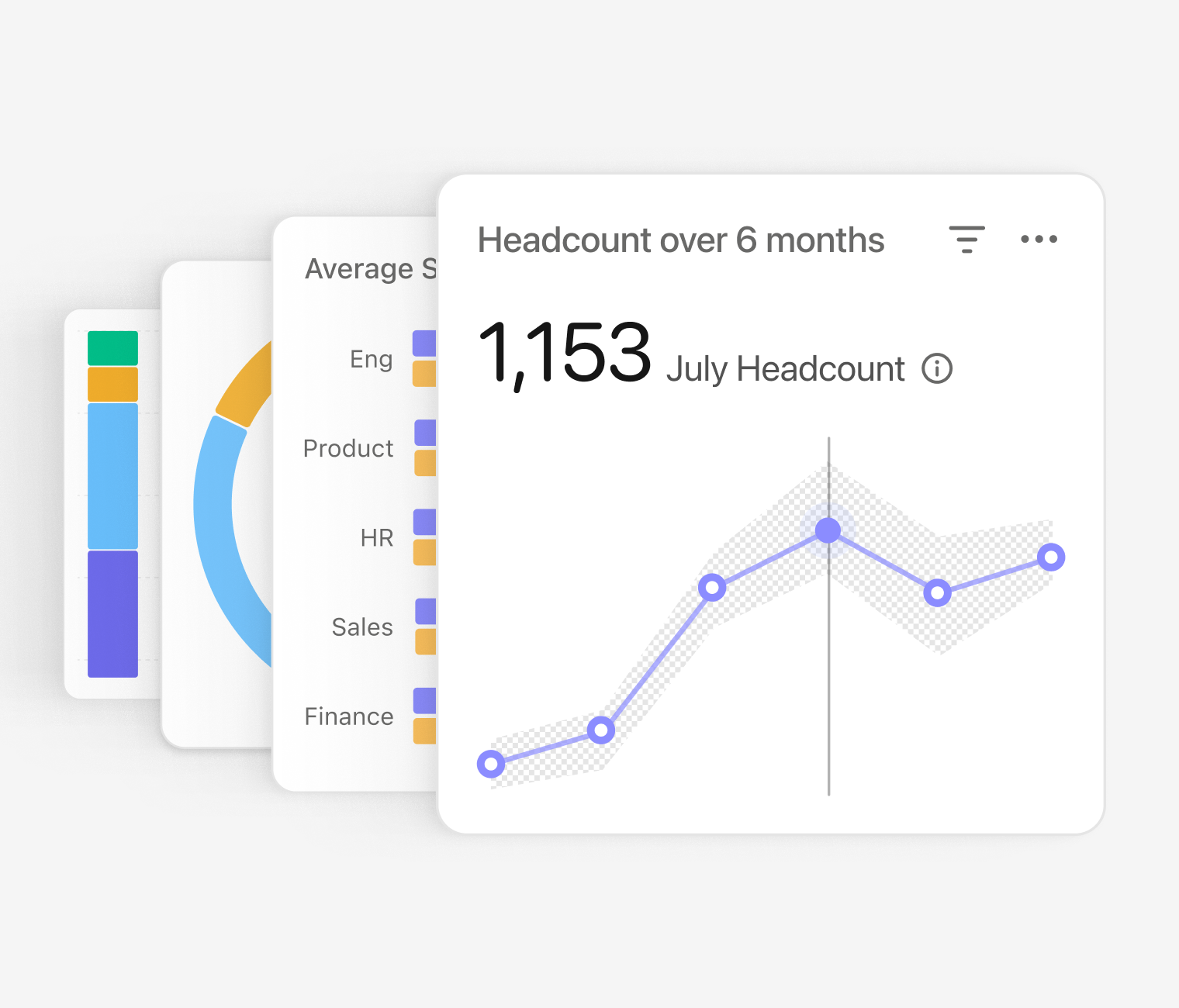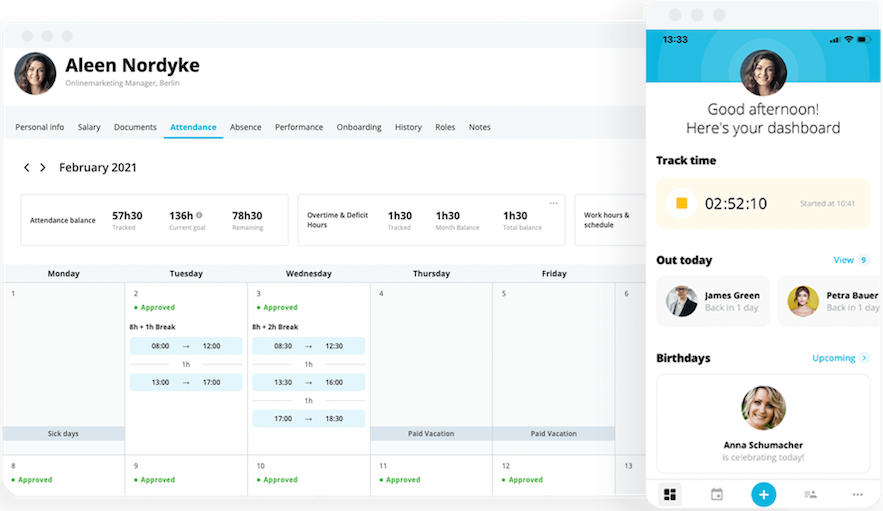
Performance Management Software
Simplify how you deliver your next performance review cycle.
Learn moreHow Can Human Capital Management Help Achieve Your Business Goals?

Human capital management (HCM) can act as a key way to enhance corporate success. Essentially, it harnesses internal human capital to achieve your goals (based on the skills of your employees).
Therefore, human capital, more generally, has a significant influence on corporate value enhancement and is a key economic factor, as well. In this article, we dive into this concept and how you can use it to ensure success.
Easily set up performance cycles with Personio and drive employee performance to new heights.What Is Human Capital Management (HCM)?
Human capital management (HCM) is made up of all the process implemented by HR, both core tasks and strategic initiatives, that help employees in their roles. It is the collection of processes designed around the topics of recruitment, management, development, and improvement to add value to a company.
Is HCM Only About Employees?
Human capital management, importantly, focuses on both employees and the structures of different groups, teams, or entire departments. It is concerned with the entire process, rather than just the individual. In that sense, HCM is all-encompassing, while still focused on the skills and abilities of people within your workforce.
Is Human Capital Management The Same As Human Resources Management?
You'll often hear the term human resources management (HRM) often used when discussing HCM. While they might be close, they are not the same thing. HRM is more about the core administrative tasks that help manage people (storing their data, tracking their time, etc.), while HCM is about maximizing the value of employees.
Think of it as a building. HRM is the foundation, it helps keep everything together and it serves a crucial role. HCM, on the other hand, is more like the facade or the design of the building. It is created with intent, partially based on its foundation, to shine in its own right.
What Is Human Capital?
If we are going to have a conversation surrounding human capital management, we also need to have a strong sense of what human capital is in the first place. Essentially, human capital is the economic impact or value that an employee has on your business — the role they play to affect your bottom line.
That said, it’s not always easy to grasp. Sure, a salesperson may have a very clear economic impact, but someone else’s impact may not be as clear (even though what is clear is that they do have an impact). The idea behind HCM, in cases like these, is to try and quantify and develop that impact over time.
What Elements Make Up Human Capital?
It’s easy to think of ‘human capital’ as a bit of a ruthless term, but it is more nuanced than simply treating employees as assets. It is about thinking of employees in terms of their ingrained, inherent value. And, when it comes to the topic of value, it can reveal itself in a handful of ways.
This might include:
Employee Skills – What employees bring to the table on a base level (education, certifications, etc.)
Work Experience – The past experiences that have shaped an employee’s way of thinking
Social Capital – How employees interact with their colleagues and managers
Everyday Capital – The everyday behaviours and habits that employees have
Brand – Based on all these, the clout that an employee has and how they use it
Each element is important on its own, of course, but we should think of them taken together. After all, every person has unique dimensions to their personality, and the same is true of the economic impact they can have on your business.
Do You Need A Human Capital Management System?
Human capital management, when done right, can be a guiding force for helping to develop and optimize the performance of every employee at your organization. The overarching idea or purpose is to maximize the impact of each individual, to help boost business performance. In that sense, we might want to think of it as a competitive advantage for businesses.
Click here to read about how strategic work can be your team’s biggest competitive advantage.
But, let’s break it down even further and work toward a human capital management system checklist. Which boxes would you want to check for your organization? Would you want:
Higher levels of employee performance
Increased levels of satisfaction
Reduced staff turnover and attrition rates
Positive effect on company culture
At the end of the day, a successful company helps their employees get better at what they do. That’s the purpose of having a human capital management system, and it’s the reason why companies should invest in it. But, you don’t need to take our word for it…
Enable Data-Led Decisions

Collect and organise important HR insights such as absences, attrition, and more. Generate detailed reports in seconds so you can strategise with confidence.
Unlock detailed HR analyticsHuman Capital Management: Relevant Research
Sudies have proven the value of strategic HR has to companies, and human capital management is part of this strategy. For example, Dr. Mark Huselid, HR analytics expert, examined the relationship between human capital management systems, corporate strategy, and corporate performance in a study.
He analysed 3,000 companies and their HCM systems over a period of ten years. What he discovered was that there was a very clear relationship between training courses offered, and lower employee turnover, along with increased sales volume.
Below, you’ll see a comparison between the best (and the worst) HCM systems…
How Do You Develop Human Capital?
We should think about human capital management as establishing an environment for employees to succeed, through multiple processes, facilitated by an organization. In order to develop it, we need to follow some familiar steps…
First, you need to select qualified employees (an effective ATS can help).
Then, you need to manage them effectively — encourage them, give them feedback, help them perform.
After that, you need to help them get better. Offer training, development, courses, whatever the case demands.
Finally, you need to be able to measure it (more on that up ahead).
Learn about driving higher levels of employee performance with Personio today.
Is Your Human Capital Management System Successful?
An important detail in all of this is measurability. This applies to the intangible value of employees as well as to the added value created by human resources. The following prerequisites help achieve this:
Qualitative and quantitative assessments, empirical data, key metrics, and performance indicators
Clear corporate goals
Defined performance goals
Clearly communicated goals (to the entire workforce)
Value-oriented core principles as part of a fully-realized corporate culture
Successful human capital management always involves carrying out specific activities and putting procedures in place. This means collecting data, analysing it, and, based on your findings, developing activities to implement.
What Goals Should You Have In Place For HCM?
The overarching goal of human capital management is to strengthen corporate performance and competitive position. To achieve this, costs must be reduced over the long term while product, process, and service quality are improved.
How do you go about doing this? By planning, monitoring, and controlling. Taking into account business and performance goals. These are some questions you should start by asking:
Which activities create value? Do any work against it?
Which factors add value and where are the risks?
To answer these questions, do not just analyse your employees. Consider teams, departments, and the entire workforce to achieve an all-encompassing response and analysis.
Need a better read of your organization? Consider an employee survey today.
Four Steps to Successful Human Capital Management
From day one, human capital management requires the utmost care. That’s why it deserves to be implemented in four unique phases to ensure success. Here they are, in order:
1. Evaluation Phase
Analyse and document all the available skills and talents in the organization. This needs to be done comprehensively, so as not to miss any crucial detail or opportunity for improvement.
2. Consolidation Phase
Now that you know the human capital available to your company, now it’s time to work with it. The next step is to check whether individual skills and talents are being used appropriately. This phase may even involve major staffing changes and further professional development.
3. Communication Phase
Communicate the planned initiatives to your employees in a face-to-face, in-house conversation. This helps ensure transparency and your plans for the future, ensuring that your workforce is not surprised or shocked by any of the changes undertaken. It is important to be clear.
4. Implementation Phase
The last three phases enabled you to gather numerous insights. This allows you to reassign some employees to new fields of responsibility where they will be motivated to apply their talents. Be sure to maintain the highest possible standards through continuing professional development, feedback sessions, and by keeping a close eye on the current state of affairs.
When profound changes take place within a company, professional change management is indispensable. This is because successful implementation relies on every employee ‘buying in’ to change.
Download our change management guidelines right here, right now.
What Is HCM Software?
Human capital management software, sometimes referred to as an HRIS or HMRS, can be an indispensable lifeline to help bring your processes to life (and help them stick). That’s because an HCM or HR software, much like Personio, can help in the following fields:
Applicant Sourcing and Tracking
Digital Employee Files
Performance and Feedback
To break it down even further, having an HR software in place can help HCM by:
Collecting and analysing relevant data.
Recording employee capabilities and skills.
Balancing business goals with available/optimal human resources.
Achieving individual performance goals and professional development concepts.
Managing performance reviews.
At its heart, effective performance management is the foundation for human capital management. When you use performance management software, you can ensure that all capabilities are properly documented.
This, ultimately, makes it easier to filter employee strengths and weaknesses. You can then deploy these skills in a way that makes sense for your workforce both productively and profitably.
Why An HCM Matters For Your Business
Human capital management is a complex topic. It relies, though, on understanding human capital as an intangible asset. The fact is that many companies underestimate this asset and unconsciously to their own detriment.
For long-term success, great HR software can emphasize the ‘management’ element of human capital management. It also makes use of all available resources, keeps them up to date, and helps your company remain successful in the long run. If you want to work with your human capital, you need to do it the right way.
